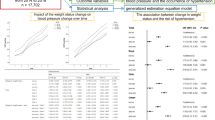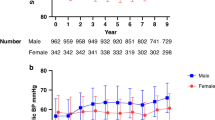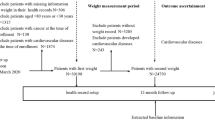Abstract
Objective
Obesity in childhood is a profound risk factor for hypertension, and weight loss has positive effects on blood pressure (BP). However, the expected effect size on BP from weight reduction in children with obesity is insufficiently described. Therefore, the aim was to investigate the association between changes of degree of obesity and BP levels.
Subjects
This prospective cohort study examined subjects receiving behavioral lifestyle modification treatment who were registered in the Swedish national registry for treatment of childhood obesity (BORIS). A total of 5279 obese subjects (51.3% boys) had repeated BP measurements. The average follow-up time was 32 months. Degree of obesity was expressed as BMI standard deviation score (SDS) and BP as BP SDS.
Results
The mean age at treatment initiation was 10.3 years. The prevalence of hypertensive BP was 15.3% for systolic and 5.5% for diastolic pressure. Both systolic and diastolic BP SDS decreased when a lower BMI SDS was achieved; systolic BP SDS decreased 0.41 [0.33–0.49] and diastolic BP SDS decreased 0.26 [0.20–0.32] per BMI SDS unit reduction. The impact of BMI SDS reduction on BP SDS was greater in subjects with hypertensive levels at treatment initiation, but behavioral modification was an insufficient treatment for 27% of them. Obesity treatment failure increased the risk of developing hypertensive levels; HR = 1.81 [1.38–2.37] (systolic BP) HR = 3.82 [2.34–6.24] (diastolic BP), per unit increase in BMI SDS.
Conclusions
Weight loss is a key factor for hypertension prevention and treatment in children with obesity. However, its limited effect suggests that additional pharmacological antihypertensive treatment more readily should be considered.
This is a preview of subscription content, access via your institution
Access options
Subscribe to this journal
Receive 12 print issues and online access
$259.00 per year
only $21.58 per issue
Buy this article
- Purchase on Springer Link
- Instant access to full article PDF
Prices may be subject to local taxes which are calculated during checkout


Similar content being viewed by others
References
Daniels SR. Complications of obesity in children and adolescents. Int J Obes. 2009;33:S60–5.
Hagman E, Reinehr T, Kowalski J, Ekbom A, Marcus C, Holl RW. Impaired fasting glucose prevalence in two nationwide cohorts of obese children and adolescents. Int J Obes. 2014;38:40–5.
Zabarsky G, Beek C, Hagman E, Pierpont B, Caprio S, Weiss R. Impact of severe obesity on cardiovascular risk factors in youth. J Pediatrics. 2018;192:105–14.
Reinehr T, Kiess W, de Sousa G, Stoffel-Wagner B, Wunsch R. Intima media thickness in childhood obesity: relations to inflammatory marker, glucose metabolism, and blood pressure. Metabolism Clin Experiment. 2006;55:113–8.
Sorof J, Daniels S. Obesity hypertension in children: a problem of epidemic proportions. Hypertension. 2002;40:441–7.
Flynn J. The changing face of pediatric hypertension in the era of the childhood obesity epidemic. Pediatr Nephrol. 2013;28:1059–66.
Cao ZQ, Zhu L, Zhang T, Wu L, Wang Y. Blood pressure and obesity among adolescents: a school-based population study in China. Am J Hypertens. 2012;25:576–82.
I’Allemand D, Wiegand S, Reinehr T, Muller J, Wabitsch M, Widhalm K, et al. Cardiovascular risk in 26,008 European overweight children as established by a multicenter database. Obesity. 2008;16:1672–9.
Reinehr T, Wiegand S, Siegfried W, Keller KM, Widhalm K, l’Allemand D, et al. Comorbidities in overweight children and adolescents: do we treat them effectively? Int J Obes. 2013;37:493–9.
Wirix AJ, Nauta J, Groothoff JW, Rabelink TJ, HiraSing RA, Chinapaw MJ. Is the prevalence of hypertension in overweight children overestimated?. Arch Dis Child. 2016;101:998–1003.
Flechtner-Mors M, Neuhauser H, Reinehr T, Roost HP, Wiegand S, Siegfried W, et al. Blood pressure in 57,915 pediatric patients who are overweight or obese based on five reference systems. Am J Cardiol. 2015;115:1587–94.
Westerstahl M, Hedvall Kallerman P, Hagman E, Ek AE, Rossner SM, Marcus C. Nocturnal blood pressure non-dipping is prevalent in severely obese, prepubertal and early pubertal children. Acta Paediatr. 2014;103:225–30.
Westerstahl M, Marcus C. Association between nocturnal blood pressure dipping and insulin metabolism in obese adolescents. Int J Obes. 2010;34:472–7.
Drukteinis JS, Roman MJ, Fabsitz RR, Lee ET, Best LG, Russell M, et al. Cardiac and systemic hemodynamic characteristics of hypertension and prehypertension in adolescents and young adults: the Strong Heart Study. Circulation. 2007;115:221–7.
Lurbe E, Cifkova R, Cruickshank JK, Dillon MJ, Ferreira I, Invitti C, et al. Management of high blood pressure in children and adolescents: recommendations of the European Society of Hypertension. J Hypertens. 2009;27:1719–42.
Zhu W, Huang X, He J, Li M, Neubauer H. Arterial intima-media thickening and endothelial dysfunction in obese Chinese children. Eur J Pediatr. 2005;164:337–44.
Lande MB, Adams H, Falkner B, Waldstein SR, Schwartz GJ, Szilagyi PG, et al. Parental assessments of internalizing and externalizing behavior and executive function in children with primary hypertension. J Pediatr. 2009;154:207–12.
Juhola J, Magnussen CG, Viikari JS, Kahonen M, Hutri-Kahonen N, Jula A, et al. Tracking of serum lipid levels, blood pressure, and body mass index from childhood to adulthood: the Cardiovascular Risk in Young Finns Study. J Pediatr. 2011;159:584–90.
Li S, Chen W, Srinivasan SR, Bond MG, Tang R, Urbina EM, et al. Childhood cardiovascular risk factors and carotid vascular changes in adulthood: the Bogalusa Heart Study. JAMA. 2003;290:2271–6.
Raitakari OT, Juonala M, Kahonen M, Taittonen L, Laitinen T, Maki-Torkko N, et al. Cardiovascular risk factors in childhood and carotid artery intima-media thickness in adulthood: the Cardiovascular Risk in Young Finns Study. JAMA. 2003;290:2277–83.
Effoe VS, Rodriguez CJ, Wagenknecht LE, Evans GW, Chang PP, Mirabelli MC, et al. Carotid intima-media thickness is associated with incident heart failure among middle-aged whites and blacks: the Atherosclerosis Risk in Communities study. J Am Heart Assoc. 2014;3:e000797.
National High Blood Pressure Education Program Working Group on High Blood Pressure in C, Adolescents. The fourth report on the diagnosis, evaluation, and treatment of high blood pressure in children and adolescents. Pediatrics. 2004;114:555–76. 2 Suppl 4th Report.
Reinehr T, Lass N, Toschke C, Rothermel J, Lanzinger S, Holl RW. Which Amount of BMI-SDS Reduction Is Necessary to Improve Cardiovascular Risk Factors in Overweight Children? J Clin Endocrinol Metabolism. 2016;101:3171–9.
Reinehr T, Schaefer A, Winkel K, Finne E, Toschke AM, Kolip P. An effective lifestyle intervention in overweight children: findings from a randomized controlled trial on “Obeldicks light”. Clin Nutr. 2010;29:331–6.
Reinehr T, de Sousa G, Toschke AM, Andler W. Long-term follow-up of cardiovascular disease risk factors in children after an obesity intervention. Am J Clin Nutr. 2006;84:490–6.
Olbers T, Gronowitz E, Werling M, Marlid S, Flodmark CE, Peltonen M, et al. Two-year outcome of laparoscopic Roux-en-Y gastric bypass in adolescents with severe obesity: results from a Swedish Nationwide Study (AMOS). Int J Obes. 2012;36:1388–95.
Danielsson P, Kowalski J, Ekblom O, Marcus C. Response of severely obese children and adolescents to behavioral treatment. Arch Pediatr Adoles Med. 2012;166:1103–8.
Danielsson P, Bohlin A, Bendito A, Svensson A, Klaesson S. Five-year outpatient programme that provided children with continuous behavioural obesity treatment enjoyed high success rate. Acta Paediatr. 2016;105:1181–90.
Cole TJ, Lobstein T. Extended international (IOTF) body mass index cut-offs for thinness, overweight and obesity. Pediatr Obes. 2012;7:284–94.
Rajjo T, Almasri J, Al Nofal A, Farah W, Alsawas M, Ahmed AT, et al. The association of weight loss and cardiometabolic outcomes in obese children: systematic review and meta-regression. J Clin Endocrinol Metabolism. 2017;102:758–62.
Golan M, Kaufman V, Shahar DR. Childhood obesity treatment: targeting parents exclusively v. parents and children. Br J Nutr. 2006;95:1008–15.
Savoye M, Shaw M, Dziura J, Tamborlane WV, Rose P, Guandalini C, et al. Effects of a weight management program on body composition and metabolic parameters in overweight children: a randomized controlled trial. JAMA. 2007;297:2697–704.
Acknowledgements
The authors would like to thank all Swedish pediatric departments and staff working with childhood obesity health care and the BORIS steering committee for establishing and maintaining the registry. We would also like to thank Ulf Hammar (Karolinska Institutet, Sweden) for statistical advice.
Funding
This research has been financially supported by the Swedish Society for Medical Research, the Swedish Heart and Lung Foundation (grant no 20150790), the Foundation of Fredrik and Ingrid Thuring (grant no 2017–00309), the Swedish Childhood Diabetes Foundation, and Stockholm County Council (ALF project, grant no 20160548).
Author contributions
AE, PD, and CM made suggestions on appropriate analytic approach and helped interpret the results, improved the initial drafts of the manuscript, and contributed to the manuscript’s development. EH performed the register linkage, conceived the study, did the analyses and drafted the initial manuscript. All authors reviewed and approved the final version of the manuscript.
Author information
Authors and Affiliations
Corresponding author
Ethics declarations
Conflict of interest
The authors declare that they have no conflict of interest.
Additional information
Publisher’s note: Springer Nature remains neutral with regard to jurisdictional claims in published maps and institutional affiliations.
Supplementary information
Rights and permissions
About this article
Cite this article
Hagman, E., Danielsson, P., Elimam, A. et al. The effect of weight loss and weight gain on blood pressure in children and adolescents with obesity. Int J Obes 43, 1988–1994 (2019). https://doi.org/10.1038/s41366-019-0384-2
Received:
Revised:
Accepted:
Published:
Issue Date:
DOI: https://doi.org/10.1038/s41366-019-0384-2
This article is cited by
-
Associations between cardiorespiratory fitness and cardiometabolic risk factors in children and adolescents with obesity
Scientific Reports (2023)
-
A hybrid machine learning approach for hypertension risk prediction
Neural Computing and Applications (2023)
-
Effect of an interactive mobile health support system and daily weight measurements for pediatric obesity treatment, a 1-year pragmatical clinical trial
International Journal of Obesity (2022)
-
Association of caffeine and caffeine metabolites with obesity among children and adolescents: National Health and Nutrition Examination Survey (NHANES) 2009–2014
Environmental Science and Pollution Research (2022)



